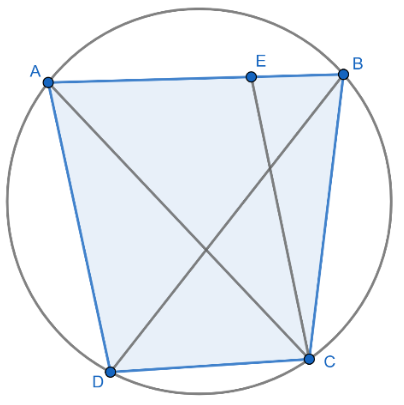
Prove that a cyclic trapezium is isosceles and its diagonals are equal.
Answer
515.7k+ views
1 likes
Hint: First we will draw the required trapezium ABCD and then we will draw a parallel line CE to AD. Then we will use that parallelogram AECD to prove that the cyclic quadrilateral is isosceles. Now we will use the SAS rule of congruence to prove that the diagonals AC and BD are equal.
Complete step-by-step solution -
Let’s first look at the diagram,

AC and BD are the diagonals and the line CE is parallel to AD.
We know that the opposite angles of a parallelogram are equal.
Therefore,
Now we also know that the sum of opposite angles of a cyclic quadrilateral is 180 degree.
Therefore,
From (1) and (2) we can say that,
Now angle AEC and CEB are linear pair,
Therefore,
Now again from (3) and (4) we can say that,
We know that the sides opposite the equal angles are also equal.
Therefore, from
CE = CB ………(5)
But we know that AECD is a parallelogram and hence opposite sides must be equal.
Therefore,
CE = AD ……….(6)
Therefore, from (5) and (6) we can say that
AD = CB ……….(7)
Thus the cyclic trapezium ABCD is isosceles.
Now for the second part,
We have the diagonals as AC and BD.
In triangle DBA and CBA,
AD = CB from (7)
AB = AB common side.
Hence, from the SAS rule.
Triangle ABD and ABC are congruent.
Note: All the properties of triangle and circle that we have used must be kept in mind. Cyclic quadrilateral is the quadrilateral which has the sum of opposite angles must be equal to 180.This is also a very important property of the cyclic quadrilateral which makes itself unique from the other quadrilaterals.
Complete step-by-step solution -
Let’s first look at the diagram,

AC and BD are the diagonals and the line CE is parallel to AD.
We know that the opposite angles of a parallelogram are equal.
Therefore,
Now we also know that the sum of opposite angles of a cyclic quadrilateral is 180 degree.
Therefore,
From (1) and (2) we can say that,
Now angle AEC and CEB are linear pair,
Therefore,
Now again from (3) and (4) we can say that,
We know that the sides opposite the equal angles are also equal.
Therefore, from
CE = CB ………(5)
But we know that AECD is a parallelogram and hence opposite sides must be equal.
Therefore,
CE = AD ……….(6)
Therefore, from (5) and (6) we can say that
AD = CB ……….(7)
Thus the cyclic trapezium ABCD is isosceles.
Now for the second part,
We have the diagonals as AC and BD.
In triangle DBA and CBA,
AD = CB from (7)
AB = AB common side.
Hence, from the SAS rule.
Triangle ABD and ABC are congruent.
Note: All the properties of triangle and circle that we have used must be kept in mind. Cyclic quadrilateral is the quadrilateral which has the sum of opposite angles must be equal to 180.This is also a very important property of the cyclic quadrilateral which makes itself unique from the other quadrilaterals.
Latest Vedantu courses for you
Grade 10 | MAHARASHTRABOARD | SCHOOL | English
Vedantu 10 Maharashtra Pro Lite (2025-26)
School Full course for MAHARASHTRABOARD students
₹33,300 per year
Recently Updated Pages
Master Class 9 General Knowledge: Engaging Questions & Answers for Success

Master Class 9 English: Engaging Questions & Answers for Success

Master Class 9 Science: Engaging Questions & Answers for Success

Master Class 9 Social Science: Engaging Questions & Answers for Success

Master Class 9 Maths: Engaging Questions & Answers for Success

Class 9 Question and Answer - Your Ultimate Solutions Guide

Trending doubts
How many ounces are in 500 mL class 8 maths CBSE

Summary of the poem Where the Mind is Without Fear class 8 english CBSE

Advantages and disadvantages of science

10 slogans on organ donation class 8 english CBSE

In Indian rupees 1 trillion is equal to how many c class 8 maths CBSE

How many ten lakhs are in one crore-class-8-maths-CBSE




